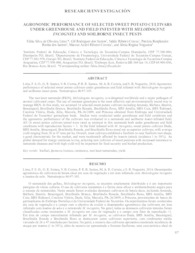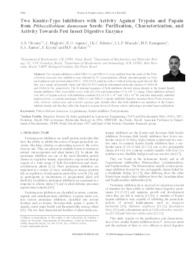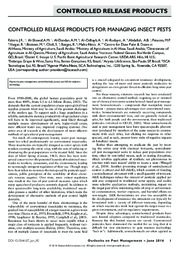Search Publications
Filter by:
| Author(s): SHARMA, K.; BOTTON, M.; BORGES, R.; MACHOTA JR, R.; SAROLI, J.; RICO, J.; SILVA, R. O. da; BERNARDI, C.; URRUTIA, W.; MAFRA, L. E. J.; MAFRA-NETO, A. Introduction: Semiochemicals (chemicals impacting insect behavior) have been employed in species-specific, ecologically friendly insect pest control strategies through a wide variety of mechanisms, ma... ... |
| Author(s): GROSSI-DE-SÁ, M. F.; PELEGRINI, P. B.; FRAGOSO, R. da R.
|
| Author(s): OLIVEIRA, C. M. de; RIBEIRO JUNIOR, W. Q.; CAMARGO, A. J. A. de; FRIZZAS, M. R.
|
| Author(s): SILVA, R. O. DA; URRUTIA, W.; PONCE, J.; BERNARDI, C.; BOTTON, M.; BORGES, R.; MACHOTA JR, R.; RICO, J.; SAROLI, J.; SHARMA, K.; MAFRA, L. E. J.; MAFRA-NETO, A. Introduction: While the advantages of semiochemical-based pest control technologies over traditional insecticides are well-documented (reduced hazards to non-targets and the environment, lower risk of... ... |
| Author(s): GILLET, F. X.; GARCIA, R. A.; MACEDO, L. L. P.; ALBUQUERQUE, E. V. S.; SILVA, M. C. M.; GROSSI-DE-SA, M. F.
|
| Author(s): LIMA, F. S. de O.; SANTOS, G. R. dos; CORREA, V. R.; SANTOS, P. R. R. dos; CORREIA, M. A. R.; NOGUEIRA, S. R. The root knot nematode (RKN), Meloidogyne incognita, is widespread worldwide and a major pathogen of several cultivated crops. The use of resistant genotypes is the most effective and environmentally... ... |
| Author(s): OLIVEIRA, A. S.; MIGLIOLO, L.; AQUINO, R. O.; RIBEIRO, J. K. C.; MACEDO, L. L. P.; BEMQUERER, M. P.; SANTOS, E. A.; KIYOTA, S.; SALES, M. P. de
|
| |
| Author(s): MACIEL, D. N.; FRAGOSO, D. de B.; BARRIGOSSI, J. A. F.; LACERDA, M. C. The resistance of rice stalk stink bug, Tibraca limbativentris Stal 1860 (Hemiptera: Pentatomidae) to five insecticides was investigated in the present study. The tested insecticides were bifenthrin,... ... |
| Author(s): FALEIRO, J. R.; AL-SHAWAF, A. M.; AL-DANDAN, A. M.; AL-ODHAYB, A.; AL-RUDAYNI, A.; ABDALLAH, A. B.; PEIXOTO, M. P.; VARGAS, R.; BOTTON, M.; CHIDI, S.; BORGES, R.; MAFRA-NETO, A. From 1900–2000, the global human population grew by more than 400%, from 1.5 to 6.1 billion (Roser, 2015). The demands that the current population places upon global food supplies presents what may be... ... |
Observation
Some of Embrapa's publications are published as ePub files. To read them, use or download one of the following free software options to your computer or mobile device. Android: Google Play Books; IOS: iBooks; Windows and Linux: Calibre.
Access other publications
Access the Agricultural Research Database (BDPA) to consult Embrapa's full library collection and records.
Visit Embrapa Bookstore to purchase books and other publications sold by Embrapa.










